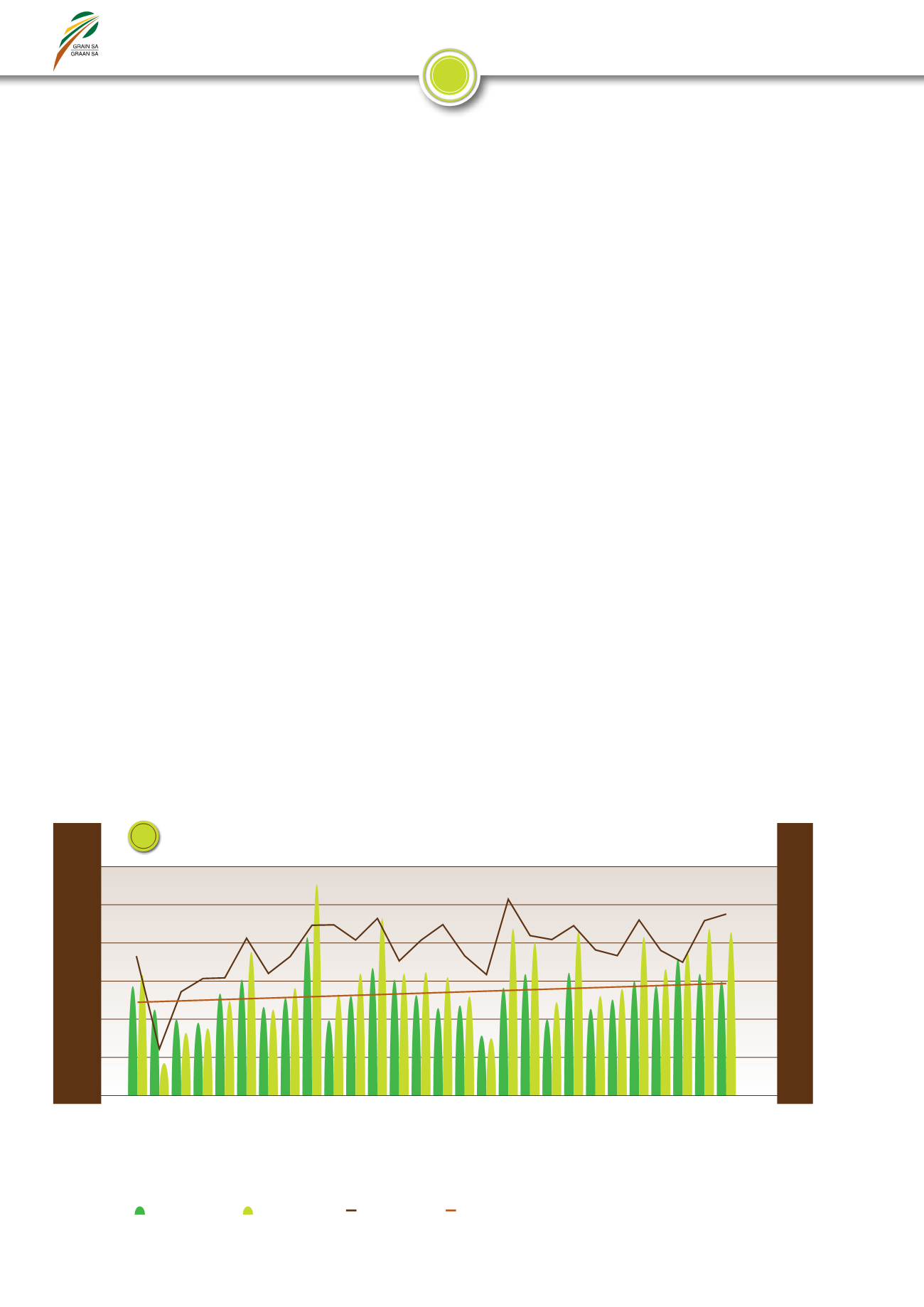

82
Jaarverslag 2018
annual report 2018
2000/2001-seisoen. Dit is duidelik dat die aanplantings, sowel as die
produksie van grondbone, die afgelope paar jaar onder druk gekom het
en dat dit ’n duidelike afwaartse tendens toon. Bydraende faktore tot
hierdie afname is stygende arbeidskoste, die prysverhouding tussen
grondbone en mielies asook die hoë kapitaalkoste verbonde aan die
meganisering van grondboonverbouing. Die totale oppervlakte van
56 300 hektaar, wat gedurende die 2017/2018-seisoen aangeplant is,
is slegs 300 hektaar meer as die vorige seisoen se oppervlakte van
56 000 ha aangeplant. Die totale produksie vir die seisoen was aan-
sienlik laer as die vorige seisoen se produksie en oor die algemeen was
dit ’n uiters uitdagende jaar vir grondboonproduksie. Daar was hierdie
seisoen ook heelwat uitdagings in terme van kwaliteit met die plaaslike
oes. Die totale produksie van 53 750 ton vir die seisoen is 42% laer as
die vorige seisoen se produksie. Die gemiddelde opbrengs van 0,95 t/ha
vir die seisoen is ook aansienlik laer as die vorige seisoen se gemid-
delde opbrengs van 1,64 t/ha.
Sojabone
Suid-Afrika se sojaboonproduksie het gedurende die 2017/2018-pro
duksieseisoen weer ’n nuwe rekordvlak bereik – beide in terme van
die oppervlakte aangeplant en produksie vir die seisoen. Die totale
oppervlakte van 787 200 hektaar, wat gedurende die 2017/2018-sei-
soen aangeplant is, is ongeveer 37% meer as die vorige seisoen se
oppervlakte aangeplant. Die totale produksie van 1,551 miljoen ton is ’n
nuwe rekord. Dit het die vorige seisoen se rekord met 18% getroef. Die
gemiddelde opbrengs vir die seisoen is volgens die NOK se finale produk
sieskatting 1,97 t/ha. Alhoewel dit laer as verlede seisoen se opbrengs
is, is dit steeds, naas verlede seisoen se rekordopbrengs van 2,29 t/ha
en die 2008/2009-seisoen se 2,17 t/ha, die derde hoogste gemiddelde
opbrengs wat nóg in Suid-Afrika verkry is.
Grafiek 7
toon die totale op-
pervlakte aangeplant, produksie en gemiddelde opbrengs van sojabone
sedert die 1990/1991-seisoen.
Droëbone
Die droëboonaanplantings vir die 2017/2018-seisoen was 53 360
hektaar, wat ’n toename van 18% in die oppervlakte aangeplant, gemeet
teen dié van die 2016/2017-seisoen, verteenwoordig. Die produksie vir
die seisoen was volgens die NOK se finale skatting van somergrane
69 360 ton. Dit het met ongeveer 1,2% vanaf die vorige seisoen se
of groundnuts has come under pressure over the past few years
and that it is demonstrating a significant downward trend. Factors
contributing to this decline are increasing labour costs, the price
ratio between groundnuts and maize, and the high capital costs of
mechanising groundnut cultivation. The total area of 56 300 hectares
planted during the 2017/2018 season was only 300 hectares more
than the previous season’s area of 56 000 hectares planted. The
total production for the season was considerably lower than the
previous seasons’ production, and in general it was an extremely
challenging year for groundnut production. This season also faced
considerable challenges in terms of the quality of the local crop. The
total production of 53 750 tons for the season was 42% lower than
the previous season’s production. The average yield of 0,95 t/ha for
the season was also considerably lower than the previous season’s
average yield of 1,64 t/ha.
Soybeans
South Africa’s soybean production achieved a new record level
again during the 2017/2018 production season – both in terms of
the area planted and production for the season. The total area
of 787 200 hectares planted during the 2017/2018 season was
approximately 37% more than the previous season’s area planted.
The total production of 1,551 million tons was a new record. It
topped the previous season’s record by 18%. According to the
CEC’s final crop estimate, the average yield for the season was
1,97 t/ha. Although this was lower than the previous season’s yield,
it was still, after the previous season’s record yield of 2,29 t/ha and
the 2,17 t/ha of the 2008/2009 season, the third highest average
yield ever obtained in South Africa.
Graph 7
shows the total area
planted, production and the average yield of soybeans in South
Africa since the 1990/1991 season.
Dry beans
The dry-bean plantings for the 2017/2018 season were 53 360
hectares, which represents an increase of 18% in the area planted
compared to that of the 2016/2017 season. According to the CEC’s
final estimate of summer grains the production for the season was
69 360 tons. It increased by approximately 1,2% from the previous
season’s 68 525 tons. The average yield of 1,3 t/ha for the season
1,8
1,6
1,4
1,2
1
0,8
0,6
0,4
0,2
0
t/ha
Sunflower seed area planted and production
Sonneblomsaadoppervlakte geplant en produksie
* Preliminary/Voorlopig
1990/1991
1991/1992
1992/1993
1993/1994
1994/1995
1995/1996
1996/1997
1997/1998
1998/1999
1999/2000
2000/2001
2001/2002
2002/2003
2003/2004
2004/2005
2005/2006
2006/2007
2007/2008
2008/2009
2009/2010
2010/2011
2011/2012
2012/2013
2013/2014
2014/2015
2015/2016
2016/2017
2017/2018*
Area
Oppervlakte
Production
Produksie
Yield
Opbrengs
Linear (Area)
Linieêr (Oppervlakte)
5
’000 ton
or/of ha
Production years
●
Produksiejare
1 200
1 000
800
600
400
200
0
















